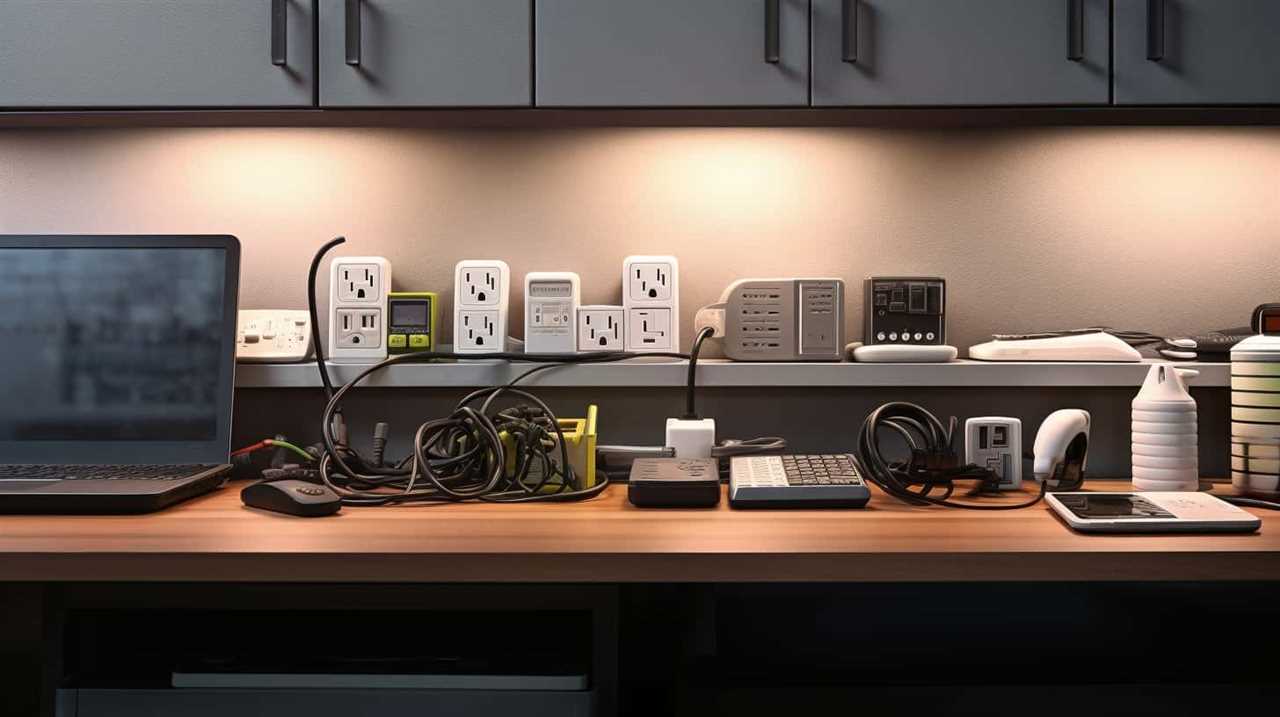A portable appliance tester, commonly referred to as a PAT, is a device used to ensure the safety and functionality of electrical appliances. It is an essential tool in various industries, including construction, manufacturing, and healthcare.
This compact device is designed to measure the electrical integrity of appliances, identifying any potential faults or hazards. By conducting regular PAT testing, businesses can comply with safety regulations and protect both their employees and customers from electrical risks.
In this comprehensive guide, we will explore the working mechanism of a portable appliance tester, the importance of PAT testing, and the benefits it brings. We will also provide tips on selecting the right device and conducting effective testing.
Whether you are a professional or simply interested in this subject, our aim is to provide you with the knowledge and resources you need to ensure electrical safety in your workplace.

Key Takeaways
- Portable appliance testers are essential devices used to test the safety and functionality of electrical appliances.
- Regular testing with a portable appliance tester is crucial for maintaining electrical safety standards and minimizing the risk of accidents or failures.
- Portable appliance testers ensure that appliances meet required safety standards set by electrical safety regulations.
- PAT testing helps meet legal requirements, maintain a safe working environment, and identify potential electrical hazards.
What Is a Portable Appliance Tester
A portable appliance tester is a device used to test the safety and functionality of electrical appliances. It is an essential piece of testing equipment in the field of electrical maintenance. These testers are designed to assess various aspects of an appliance, including insulation resistance, earth continuity, and polarity.
By conducting these tests, portable appliance testers ensure that electrical appliances are in proper working order and free from potential hazards. They help identify any faults or defects that may pose a risk to users or compromise the performance of the appliance.
Regular testing with a portable appliance tester is crucial for maintaining electrical safety standards and minimizing the risk of accidents or electrical failures. These devices are widely used in industrial, commercial, and residential settings to ensure the safe and efficient operation of electrical appliances.
How Does a Portable Appliance Tester Work
A portable appliance tester works by testing the electrical safety of appliances. It does this by conducting a series of tests to assess the integrity of the appliance’s electrical components.

The portable appliance testing process typically involves visual inspections, earth continuity tests, insulation resistance tests, and functional checks to ensure that the appliance is safe to use.
Testing Electrical Safety
Portable Appliance Testers are essential devices used for ensuring electrical safety by efficiently testing the functionality and safety of various appliances.
To understand how a portable appliance tester works, it is important to consider the following:
- Compliance with electrical safety regulations:
Portable Appliance Testers are designed to ensure that appliances meet the required safety standards set by electrical safety regulations. They evaluate the electrical insulation, earthing, and leakage current of appliances to determine their safety. - Importance of regular maintenance:
Portable Appliance Testers play a crucial role in maintaining electrical safety by regularly testing appliances for faults or defects. Regular testing helps identify potential hazards and prevent electrical accidents.
Portable Appliance Testing Process
The process of testing appliances using a portable appliance tester involves evaluating their electrical safety and functionality. Portable appliance testers (PAT) are designed to assess the condition of electrical equipment, ensuring that it is safe for use. These devices perform various tests, including insulation resistance, earth continuity, and leakage current tests. By conducting these tests, the PAT can identify any potential faults or defects in the appliance’s electrical system.

This process not only helps to prevent electrical accidents and fires but also ensures compliance with safety regulations. The benefits of using a portable appliance tester include increased workplace safety, reduced risk of electrical hazards, and improved equipment reliability. While the cost of portable appliance testing may vary depending on factors such as the number of appliances and the complexity of testing required, it is a worthwhile investment in maintaining a safe working environment.
With the understanding of how the portable appliance testing process works, we can now explore the importance of PAT testing.
Importance of PAT Testing
The significance of Portable Appliance Tester (PAT) testing lies in ensuring the safety and compliance of electrical equipment. Conducting regular PAT testing provides several benefits and allows businesses and individuals to meet legal requirements and maintain a safe working environment.
Here are some tips for conducting effective PAT testing:

- Use a qualified and competent person to carry out the testing.
- Follow a systematic approach, inspecting equipment for any visible damage or defects.
- Conduct appropriate electrical tests, such as earth continuity, insulation resistance, and functional checks.
- Keep accurate records of the testing results, including the date of testing and the equipment’s identification.
Benefits of Regular PAT Testing
Conducting regular PAT testing provides numerous advantages for businesses and individuals.
One of the main benefits of regular PAT testing is the identification of potential electrical hazards in appliances. Common electrical hazards include faulty wiring, insulation deterioration, and loose connections, which can lead to electrical shocks, fires, or even fatalities. By regularly testing appliances, these hazards can be identified and rectified before they cause any harm.
Additionally, regular PAT testing ensures compliance with safety regulations and reduces the risk of legal liabilities.
It also helps in maintaining the efficiency and reliability of appliances, preventing unexpected breakdowns and minimizing the disruption to operations.

PAT Testing in the Workplace
In the workplace, PAT testing plays a crucial role in ensuring the safety of employees and compliance with regulatory standards.
It involves the inspection and testing of portable appliances to identify potential electrical faults or hazards.
Importance of PAT Testing
PAT testing plays a vital role in ensuring the safety and compliance of electrical appliances in the workplace. Regular maintenance is crucial to keep appliances functioning properly and to minimize the risk of accidents or electrical hazards.
Here are two key reasons why PAT testing is important:

- Importance of Regular Maintenance:
- Regular testing and inspection help identify any faults or defects in electrical appliances.
- This allows for timely repairs or replacements, reducing the chances of malfunction or electrical accidents.
- Cost Effectiveness of PAT Testing:
- By identifying and fixing faults early on, PAT testing helps avoid costly repairs or replacements in the long run.
- It also helps prevent potential workplace accidents, which can lead to legal liabilities and financial losses.
Compliance and Safety
Ensuring compliance and safety in the workplace through regular testing and inspection of electrical appliances is paramount. Adhering to compliance standards and implementing effective electrical equipment maintenance practices are essential for preventing accidents, protecting employees, and avoiding costly legal consequences. Portable Appliance Testing (PAT) plays a crucial role in achieving these goals by assessing the safety of electrical appliances and identifying potential risks. PAT testing involves a systematic examination of appliances, including visual inspections, earth continuity checks, insulation resistance tests, and functional checks. By conducting these tests periodically, businesses can ensure that their electrical equipment remains in good working condition, minimizing the risk of electrical hazards and ensuring compliance with safety regulations. The following table highlights some key compliance standards and guidelines relevant to electrical equipment maintenance:
| Compliance Standards | Description |
|---|---|
| IEC 62353 | Standard for the in-service testing of electrical medical equipment |
| IEC 61174 | Standard for the testing and inspection of navigational equipment on ships |
| IET Code of Practice | Guidance for the maintenance of electrical installations and equipment |
| Workplace Health & Safety Regulations | Regulations outlining safety requirements for electrical equipment |
Legal Requirements for PAT Testing
To comply with legal regulations, individuals must adhere to specific requirements when conducting Portable Appliance Testing (PAT). This ensures that electrical equipment used in the workplace is safe for employees and the public.
The legal obligations surrounding PAT testing include:
- Compliance regulations:
- The Health and Safety at Work Act 1974 requires employers to provide a safe working environment, including electrical safety.
- The Electricity at Work Regulations 1989 outline the responsibilities of employers to maintain electrical systems.
- Specific legal requirements for PAT testing:
- Regular inspection and testing of portable appliances.
- Keeping records of all tests conducted.
- Displaying test results on equipment or providing labels.
- Ensuring that testing is carried out by competent individuals.
Understanding and complying with these legal obligations is crucial for maintaining workplace safety.

Now let’s delve into the next section, which covers common electrical hazards in appliances.
Common Electrical Hazards in Appliances
When it comes to electrical appliances, it is crucial to identify and understand the potential risks they pose. Common electrical hazards in appliances include:
- Faulty wiring
- Improper grounding
- Insulation breakdown
Ensuring appliance safety involves regular inspection and maintenance to prevent accidents and electrical fires.
Identifying Potential Risks
The identification of potential risks associated with common electrical hazards in appliances is crucial for maintaining electrical safety. To ensure a thorough understanding of these risks, it is important to consider the following:

- Electrical Overload:
- Overloading electrical circuits beyond their capacity can lead to overheating, fires, and damage to appliances.
- Safety measures: Avoid plugging too many appliances into a single outlet or power strip. Distribute the load evenly across multiple circuits.
- Faulty Wiring:
- Poorly installed or deteriorated wiring can cause electrical shocks, short circuits, and fires.
- Safety measures: Regularly inspect wiring for signs of damage or wear. Hire a licensed electrician to address any issues promptly.
Ensuring Appliance Safety
Appliance safety can be ensured by conducting regular tests using a portable appliance tester.
Ensuring appliance maintenance is crucial to prevent electrical hazards and promote overall safety. Electrical inspections play a vital role in identifying potential risks and taking necessary measures to mitigate them.
Regular testing using a portable appliance tester helps in detecting any faults or malfunctions in electrical appliances, such as frayed wires, loose connections, or insulation breakdowns. These tests are essential for maintaining the integrity of the appliances and preventing accidents, fires, or electric shocks.
Signs That Your Appliances Need PAT Testing
To determine if your appliances require PAT testing, look out for telltale indicators of potential electrical hazards. Here are some signs that your appliances may need PAT testing:

- Age: Older appliances are more prone to wear and tear, which can increase the risk of electrical faults.
- Damage: Any visible damage, such as frayed wires, cracked casings, or loose connections, should be addressed immediately.
- Malfunctions: If your appliances are not functioning properly or have intermittent power issues, it could be a sign of underlying electrical problems.
- Environmental factors: Appliances used in harsh environments, such as construction sites or industrial settings, are more likely to suffer from electrical faults.
- Changes in usage: If you start using an appliance more frequently or in a different way, it is important to ensure it can handle the increased load.
By being vigilant and addressing these signs, you can prevent electrical accidents caused by faulty appliances.
Now, let’s explore the differences between DIY PAT testing and professional testing.
DIY PAT Testing Vs Professional Testing
When comparing DIY PAT testing to professional testing, it is essential to consider the expertise and accuracy that a trained technician brings to the process.
While DIY PAT testing may seem like a cost-effective option, it is important to acknowledge the challenges that come with it. One of the main challenges is the lack of knowledge and understanding of electrical systems and safety regulations. Without proper training, individuals may overlook potential hazards or fail to accurately assess the condition of appliances. This can lead to faulty testing results and increased risks of electrical accidents.

On the other hand, professional testing guarantees the involvement of qualified technicians who possess the necessary skills and knowledge to perform accurate and thorough inspections. While it may come at a higher cost, professional testing ensures compliance with safety standards and minimizes the risk of accidents caused by faulty appliances.
Choosing the Right Portable Appliance Tester
To ensure accurate and reliable results, it is crucial to select the appropriate portable appliance tester. When choosing a portable appliance tester, it is important to consider the following factors:
- Features: Different testers offer different features, such as the ability to perform insulation resistance tests, earth continuity tests, and leakage current tests. Look for a tester that offers the necessary features for your specific testing requirements.
- Brand reputation: It is advisable to choose a portable appliance tester from a reputable brand. Well-known brands often have a track record of producing reliable and high-quality testing equipment.
Additionally, when considering portable appliance testers, it is important to be aware of the benefits they offer. These include:
- Ensuring the safety of electrical appliances
- Reducing the risk of electrical accidents
- Complying with legal and regulatory requirements
Tips for Conducting Effective PAT Testing
For effective PAT testing, it is essential to follow a systematic approach. Following best practices will ensure accurate results and maintain the safety of electrical appliances.

One of the most common mistakes in PAT testing is neglecting to visually inspect the appliance before testing. A thorough visual inspection allows for the identification of any visible damages or defects that may affect the safety of the appliance during testing.
Another common mistake is not using the appropriate test equipment for different appliance types. It is important to select the correct portable appliance tester for each specific appliance to ensure accurate and reliable results.
Additionally, documenting and keeping records of all tests and results is crucial for compliance and future reference.
What to Do If an Appliance Fails PAT Testing
If an appliance fails PAT testing, it is important to take immediate action to address the safety concerns and prevent any potential hazards. Here are some steps to follow when dealing with a failed PAT test:

- Diagnosing faulty appliances:
- Inspect the appliance for visible damage or signs of wear and tear.
- Check the power cord, plug, and socket for any defects or loose connections.
- Troubleshooting PAT testing failures:
- Retest the appliance using a different PAT tester or test method to rule out any equipment issues.
- If the appliance still fails, consult the manufacturer’s guidelines or contact a qualified professional for further assistance.
By promptly diagnosing faulty appliances and troubleshooting PAT testing failures, you can ensure the safety of your workplace and prevent potential accidents.
Now, let’s move on to the next section, which addresses frequently asked questions about portable appliance testing.
FAQs about Portable Appliance Testing
FAQs About Portable Appliance Testing
The FAQs about portable appliance testing provide valuable information for those seeking to understand the process and requirements of this important safety procedure.
One common FAQ is about PAT certification. People often wonder if they need to have PAT certification to carry out portable appliance testing. While PAT certification is not a legal requirement, it is highly recommended as it demonstrates that the tester has received proper training and possesses the necessary knowledge and skills to perform the testing correctly.

Another common misconception about portable appliance testing is that it is only necessary for electrical appliances. In reality, any portable appliance that is used in a workplace or public environment should be tested regularly for safety, regardless of whether it is electrical or not.
It is important to address these FAQs and misconceptions to ensure a comprehensive understanding of portable appliance testing.
Frequently Asked Questions
How Often Should I Conduct PAT Testing on My Appliances?
To properly maintain appliances after pat testing, it is recommended to conduct testing at regular intervals. The frequency depends on factors such as the type of appliance, its usage, and the environment. It is advisable to choose a reliable pat testing service for accurate and thorough testing.
Can I Perform PAT Testing on My Own Without Hiring a Professional?
Performing Portable Appliance Testing (PAT) without professional assistance may compromise accuracy, reliability, and adherence to safety standards. Engaging a qualified professional ensures meticulous examination, comprehensive reporting, and compliance with regulations, guaranteeing utmost safety for individuals and properties.

Are There Any Specific Legal Requirements for PAT Testing in Residential Settings?
There are specific legal implications and safety regulations regarding PAT testing in residential settings. It is important to adhere to these requirements to ensure the safety of individuals and comply with legal obligations.
How Long Does a PAT Testing Session Usually Take?
The average duration of a portable appliance testing (PAT) session can vary depending on several factors, including the number of appliances, their complexity, and the experience of the tester. Cost factors may also influence the duration.
Can PAT Testing Detect All Potential Electrical Hazards in an Appliance?
Pat testing, while effective in identifying common electrical hazards, has limitations. It may not detect all potential hazards in an appliance. Common electrical hazards missed include internal faults and insulation breakdown. Regular maintenance and visual inspection are also crucial for comprehensive safety assessment.
Conclusion
In conclusion, portable appliance testing (PAT) is a crucial process for ensuring the safety and functionality of electrical appliances. By regularly conducting PAT tests, businesses can identify any potential faults or hazards, minimizing the risk of accidents and electrical fires.

Choosing the right portable appliance tester and following effective testing procedures are essential for maintaining a safe working environment. By adhering to these guidelines, businesses can prioritize the safety of their employees and comply with legal regulations.










